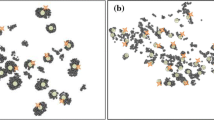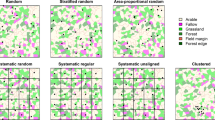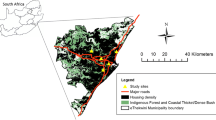Abstract
Spatial ecology is becoming an increasingly important component of resource management, and the general monitoring of how human activities affect the distribution and abundance of wildlife. Yet most work on the reliability of sampling strategies is based on a non-spatial analysis of variance paradigm, and little work has been done assessing the power of alternative spatial methods for creating reliable maps of animal abundance. Such a map forms a critical response variable for multiple scale studies relating landscape structure to biotic function. The power to reconstruct patterns of distribution and abundance is influenced by sample placement strategy and density, the nature of spatial auto-correlation among points, and by the technique used to extrapolate points into an animal abundance map. Faced with uncertainty concerning the influence of these factors, we chose to first synthesize a model reference system of known properties and then evaluate the relative performance of alternative sampling and mapping procedures using it. We used published habitat associations of tree nesting boreal neo-tropical birds, a classified habitat map from the Manitou Lakes area of northwestern Ontario, and point count means and variances determined from field studies in boreal Canada to create 4 simulated models of avian abundance to function as reference maps. Four point sampling strategies were evaluated by 4 spatial mapping methods. We found mixed-cluster sampling to be an effective point sampling strategy, particularly when high habitat fragmentation was avoided by restricting samples to habitat patches >10 ha in size. We also found that of the 4 mapping methods, only stratified ordinary point kriging (OPK) was able to generate maps that reproduced an embedded landscape-scale spatial effect that reduced nesting bird abundance in areas of higher forest age-class fragmentation. Global OPK was effective only for detecting broader, regional-scale differences.
Similar content being viewed by others
References
Andren H. 1994. Effects of habitat fragmentation on birds and mammals in landscapes with different proportions of suitable habitat: a review. Oikos 71: 355–366.
Austen M.J.W., Francis C.M., Burke D.M. and Bradstreet M.S.W. 2001. Landscape context and fragmentation effects on forest birds in southern Ontario. Condor 103: 701–714.
Bellehumeur C. and Legendre P. 1998. Multiscale sources of variation in ecological variables: modeling spatial dispersion, elaborating sampling designs. Landscape Ecology 13: 15–25.
Benedetti-Cecchi L. 2001. Beyond Baci: Optimization of environmental sampling designs through monitoring and simulation. Ecological Applications 11: 783–799.
Boone R.B. and Krohn W.B. 2000. Predicting broadscale occurrences of vertebrates in patchy landscapes. Landscape Ecology 15: 63–74.
Boulinier T., Nichols J.D., Hines J.E., Sauer J.R., Flather C.H. and Pollock K.H. 2001. Forest fragmentation and bird community dynamics: Inference at regional scales. Ecology 82: 1159–1169.
Burrough P.A. 2001. GIS and geostatistics: Essential partners for spatial analysis. Environmental and Ecological Statistics 8: 361–377.
Carlson M. 2001. Cost-effective sampling design for large-scale avian monitoring. MS Thesis, University of Alberta: Edmonton, Alberta, Canada. 89 pp.
Dale M.R.T. and Fortin M.J. 2002. Spatial autocorrelation and statistical tests in ecology. Ecoscience 9: 162–167.
Davis B.M. 1987. Uses and abuses of cross validation in geostatistics. Mathematical Geology 19: 242–248.
Dessard H. 1999. Comparison of design-based and model-based estimates for tropical forestry resource with post-stratification. Annals of Forest Science 56: 651–665.
Elkie P.C. and Rempel R.S. 2001. Detecting scales of pattern in boreal forest landscapes. Forest Ecology and Management 147: 253–261.
Elliott J.M., 1977. Some Methods for the Statistical Analysis of Samples of Benthic Invertebrates. The Ferry House, England.
Fortin M.J., Drapeau P. and Legendre P. 1989. Spatial autocorrelation and sampling design in plant ecology. Vegetatio 83: 209–222.
Fortin M.J. and Payette S. 2002. How to test the significance of the relation between spatially autocorrelated data at the landscape scale: A case study using fire and forest maps. Ecoscience 9: 213–218.
Foster D.R., Knight D.H. and Franklin J.F. 1998. Landscape patterns and legacies resulting from large, infrequent forest disturbances. Ecosystems 1: 497–510.
Foster J.R. 2001. Statistical power in forest monitoring. Forest Ecology and Management 151: 211–222.
Goovaerts P., 1997. Geostatistics for Natural Resources Evaluation. Oxford University Press, New York, New York, USA.
Gunnarsson F., Holm S., Holmgren P. and Thuresson T. 1998. On the potential of Kriging for forest management planning. Scandinavian Journal of Forest Research 13: 237–245.
Hall F.G., Strebel D.E. and Sellers P.J. 1988. Linking knowledge among spatial and temporal scales: vegetation, atmosphere, climate and remote sensing. Landscape Ecology 2: 3–22.
Hayes J.P. and Steidl R.J. 1997. Statistical power analysis and amphibian population trends. Conservation Biology 11: 273–275.
Hobson K.A. and Schieck J. 1999. Changes in bird communities in boreal mixedwood forest: Harvest and wildfire effects over 30 years. Ecological Applications 9: 849–863.
Hobson K.A., Kirk D.A. and Smith A.R. 2000. A multivariate analysis of breeding bird species of western and central Canadian boreal forests: Stand and spatial effects. Ecoscience 7: 267–280.
Hunsaker C.T., Goodchild M.F., Friedl M.A. and Case T.J. 2001. Spatial Uncertainty in Ecology. Springer-Verlag New York, Inc.: New York, New York, USA.
Kotliar N.B. and Wiens J.A. 1990. Multiple scales of patchiness and patch structure: a hierarchical framework for the study of heterogeneity. Oikos 59: 253–260.
Legendre P. and Fortin M.J. 1989. Spatial pattern and ecological analysis. Vegetatio 80: 107–138.
Legendre P. 1993. Spatial autocorrelation: trouble or new paradigm? Ecology 74: 1659–1673.
Lichstein J.W., Simons T.R., Shriner S.A. and Franzreb K.E. 2002. Spatial autocorrelation and autoregressive models in ecology. Ecological Monographs 72: 445–463.
Liebhold A.M. and Gurevitch J. 2002. Integrating the statistical analysis of spatial data in ecology. Ecography 25: 553–557.
Lin Y.P. and Rouhani S. 2001. Multiple-point variance analysis for optimal adjustment of a monitoring network. Environmental Monitoring and Assessment 69: 239–266.
Lowell K. and Jaton A. 1999. Spatial Accuracy Assessment: Land Information Uncertainty in Natural Resources. Ann Arbor Press, Chelsea, Michigan, USA.
McKenney D.W., Rempel R.S., Venier L.A., Wang Y.H. and Bisset A.R. 1998. Development and application of a spatially explicit moose population model. Canadian Journal of Zoology 76: 1922–1931.
Meisel J.E. and Turner M.G. 1998. Scale detection in real and artificial landscapes using semivariance analysis. Landscape Ecology 13: 347–362.
Potvin F., Lowell K., Fortin M.J. and Belanger L. 2001. How to test habitat selection at the home range scale: A resampling random windows technique. Ecoscience 8: 399–406.
Rossi R.E., Mulla D.J., Journel A.G. and Franz E.H. 1992. Geostatistical tools for modeling and interpreting ecological spatial dependence. Ecological Monographs 62: 277–314.
Roy P.S. and Tomar S. 2000. Biodiversity characterization at landscape level using geospatial modelling technique. Biological Conservation 95: 95–109.
Royle J.A. and Berliner L.M. 1999. A hierarchical approach to multivariate spatial modeling and prediction. Journal of Agricultural Biological and Environmental Statistics 4: 29–56.
Ryan K.C. 2002. Dynamic interactions between forest structure and fire behavior in boreal ecosystems. Silva Fennica 36: 13–39.
Sadahiro Y. 1999. Accuracy of areal interpolation: a comparison of alternative methods. CSIS Discussion Paper No. 9. Center for Spatial Information Science and Department of Urban Engineering, University of Tokyo, Tokyo, Japan, 41 p.
Saura S. and Martinez-Millan J. 2000. Landscape patterns simulation with a modified random clusters method. Landscape Ecology 15: 661–678.
Steidl R.J., Hayes J.P. and Schauber E. 1997. Statistical power analysis in wildlife research. Journal of Wildlife Management 61: 270–279.
Thompson F.R., Burhans D.E. and Root B. 2002. Effects of point count protocol on bird abundance and variability estimates and power to detect population trends. Journal of Field Ornithology 73: 141–150.
Valliant R., Dorfman A.H. and Royall R.M. 2000. Finite Population Sampling and Inference: A Prediction Approach. John Wiley & Sons Inc., New York, New York, USA..
van Groenigen J.W. 2000. The influence of variogram parametersz on optimal sampling schemes for mapping by kriging. Geoderma 97: 223–236.
Venier L.A., McKenney D.W., Wang Y. and McKee J. 1999. Models of large-scale breeding-bird distribution as a function of macro-climate in Ontario, Canada. Journal of Biogeography 26: 315–328.
Vernier P.R., Schmiegelow F.K.A., and Cumming S.G. 2002. Modelling bird abundance from forest inventory data in the boreal mixedwood forests of Canada. In: Scott J.M., Heglund P.J. and Morrison M.L., Predicting Species Occurrences: Issues of Accuracy and Scale, pp. 559–572. Island Press: Washinton, D.C., USA.
Villard M.-A. and Maurer B.A. 1996. Geostatistics as a tool for examining hypothesized declines in migratory songbirds. Ecology 77: 59–68.
Wallerman J., Joyce S., Vencatasawmy C.P. and Olsson H. 2002. Prediction of forest stem volume using kriging adapted to detected edges. Canadian Journal of Forest Research 32: 509–518.
Zar J.H. 1984. Biostatistical Analysis. Prentice Hall, Englewood Cliffs, New Jersey, USA.
Author information
Authors and Affiliations
Rights and permissions
About this article
Cite this article
Rempel, R.S., Kushneriuk, R.S. The influence of sampling scheme and interpolation method on the power to detect spatial effects of forest birds in Ontario (Canada). Landscape Ecology 18, 741–757 (2003). https://doi.org/10.1023/B:LAND.0000014469.30984.24
Issue Date:
DOI: https://doi.org/10.1023/B:LAND.0000014469.30984.24




